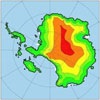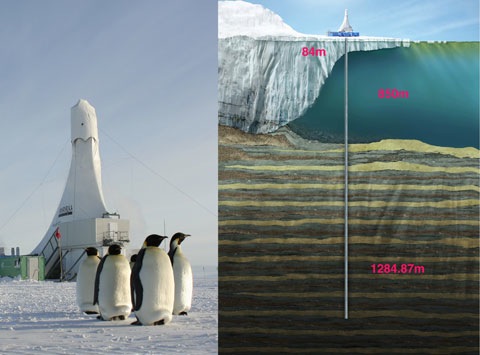 The last time that atmospheric CO2 levels were as high as today, the West Antarctic Ice Sheet (WAIS) regularly retreated or collapsed, causing sea level rises of up to 7 metres according to the first analysis of the first ANDRILL core, published in Nature today. The ANDRILL (Antarctic Geological Drilling) programme, a joint effort by scientists from New Zealand, Italy, the USA and Germany, drilled a 1,280 metre core from the seabed under the Ross Ice Shelf. It’s the longest and most complete drill core recovered from Antarctica, and was made possible by drilling technology developed by a team at the Antarctic Research Centre at Victoria University of Wellington led by Alex Pyne.
The last time that atmospheric CO2 levels were as high as today, the West Antarctic Ice Sheet (WAIS) regularly retreated or collapsed, causing sea level rises of up to 7 metres according to the first analysis of the first ANDRILL core, published in Nature today. The ANDRILL (Antarctic Geological Drilling) programme, a joint effort by scientists from New Zealand, Italy, the USA and Germany, drilled a 1,280 metre core from the seabed under the Ross Ice Shelf. It’s the longest and most complete drill core recovered from Antarctica, and was made possible by drilling technology developed by a team at the Antarctic Research Centre at Victoria University of Wellington led by Alex Pyne.

The two Nature papers [1. Obliquity-paced Pliocene West Antarctic ice sheet oscillations, Naish et al, Nature, 19 March 2009 doi:10.1038/nature07867, and Modelling West Antarctic ice sheet growth and collapse through the past five million years, Pollard and DeConto, doi:10.1038/nature07809] focus on the “warm Pliocene” between two and five million years ago when CO2 levels were around 400 ppm. This is considered a good analogue for where our climate is headed, and the consequence, according to Professor Tim Naish of VUW, joint science head of ANDRILL, is that if we reach 550 ppm CO2 and a resulting 3ºC increase in global temperature, then large parts of the WAIS could melt on timescales of the order of centuries, and be completely gone within a thousand years.
The ANDRILL core documents 38 advances and retreats of the ice sheet, and suggests that during the warm Pliocene the key driver could have been the “obliquity” cycle in the earth’s orbit around the sun — a 40,000 year tilt in the Earth’s axis towards and away from the sun that affects the length of summers at the poles. New modelling of the ice sheet[2. Pollard & DeConto] confirms the link with the obliquity cycle, and suggests that the primary mechanism is melting of the base of the ice sheet by warm oceanic waters — a process that has already started.
In other WAIS news, a British team reports on the success of their robot submarine, Autosub, which made voyages of up to 110km under the Pine Island Glacier ice shelf, recording temperature and salinity, and providing valuable data about melting at the glacier grounding line.
More coverage: Nature commentary by Phillipe Huybrechts, Science Daily, the Telegraph, AP and Reuters.
[Pulp]

Damn…
400 ppm? Ouch!
Why is it the more I learn…the more I wish I didn’t?
Oh well; looks like I’ve have some more reading to do…
The 400 ppm threshold has been known about for two or three years. Hansen’s 350 ppm limit is based on it (with a 50 ppm safety margin).
You’re right of course Steve.
I should have remembered that.
I have in print somewhere in one of my books (6 Degrees maybe? ) that plant fossils found in the antarctic revealed that they grew in CO2 levels that match our current level.
I’m trying to remember, but I think the sea levels from the same era as the fossilized plants were much, much higher than our current sea levels.
I’ve got to look that up….how could I have forgot!
One interesting feature of the two papers is that they link the collapses to ocean temperatures. A future paper is going to discuss what the open water sections of the cores imply for SSTs at the time. The Toggweiler commentary accompanying the ANDRILL papers goes into more detail about the possible mechanism. I also understand (though didn’t get much chance to explore with the authors) that the warm Pliocene ice sheet/SST behaviour implies a somewhat higher climate sensitivity than is currently thought.
Still not very encouraging, Tom, I’m afraid.
I found the information I was looking for and it was in Six Degrees by Mark Lynas.
The chapter Three Degrees starting at page 117.
Geologist Jane Francis with colleague Robert Hill discovered the fossil plants in the Dominion Range of the Transantarctic Mountains 500 km from the south pole.
The fossils are so well preserved that the leaf stomata, the tiny holes in the leaves used for CO2/Oxygen exchange during photosynthesis could be counted.
The conclusion was CO2 levels in the Pliocene varied between 360 to 400 ppm.
It was 3 degrees C warmer then, but Mark Lynas points out that the earth’s “thermal inertia” will prevent an overnight jump in global temperature of 3 degrees C.
But I think I’m beginning to understand that it doesn’t have to reach an air temperature 3 degrees C warmer before other massive changes can occur.
Maybe a direct, rigid comparison to the Pliocene era is wise since this sensitivity thing is hanging over our heads and the wild card in this whole scenario is the rate of change of CO2 levels in the atmosphere.
We are in a few centuries doing what took nature thousands of years to do and now we are upping the ante to decades…full speed ahead and damn the inertia!
Darn…
A direct, rigid comparison to the Pliocene is UNwise…
I must start editing my edits…
How do they take into account isostatic rebound?
If one thinks that the ground rises when the ice on top of it is removed, then that could complicate the ice issues somewhat. Maybe it’s not that major in this case.
I’m too lazy to actually research that… But meters of rebound can happen easily in a few thousand years. I know, I’m living in Finland – some ground rise changes are visible during just a human lifetime.
I just wanted to note that there seems to be a bit of a public disagreement between Naish and Pollard over prospects for a (century-scale) collapse as opposed to a (millennial-scale) retreat. Naish’s position is that the model isn’t fine-grained enough to exclude the possibility, and that present observed behavior of the WAIS is too abrupt to take the model results as a constraint on the potential pace of collapse.
I am thinking of becoming a recession skeptic… similar to the climate ones… I am sure I can use their tactics.
Where is your proof of a recession? I have read some newspaper articles on how the recession is a lie and it’s just a tax gimmick for big companies to get my money.
There is also money in it for these people who are economists… they only care about making money from this recession con.